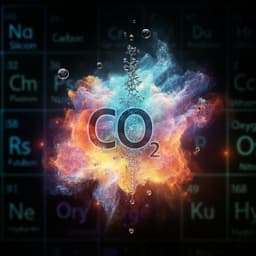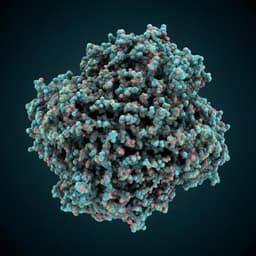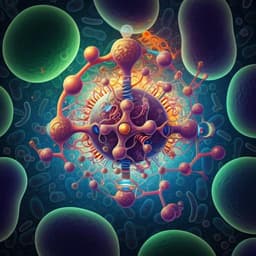
Chemistry
A photocatalytic redox cycle over a polyimide catalyst drives efficient solar-to-H₂O₂ conversion
W. Chi, Y. Dong, et al.
Discover the groundbreaking engineering of a polyimide aerogel photocatalyst, which produces H₂O₂ efficiently through a unique photocatalytic redox cycle. Researchers Wenwen Chi, Yuming Dong, Bing Liu, Chengsi Pan, Jiawei Zhang, Hui Zhao, Yongfa Zhu, and Zeyu Liu have achieved an impressive 14.28% quantum yield and substantial H₂O₂ production under sunlight exposure.
~3 min • Beginner • English
Introduction
Hydrogen peroxide is an important green oxidant and energy carrier used in healthcare, disinfection, wastewater treatment, and synthesis, but over 95% of current production relies on energy-intensive, palladium-catalyzed anthraquinone processes that pose environmental concerns. Photocatalytic H2O2 production from water and oxygen using organic semiconductors is a sustainable alternative, yet is hindered by rapid electron–hole recombination and competing one- and four-electron O2 reduction pathways that limit selectivity and quantum efficiency. Inspired by photosynthesis, where redox mediators channel electrons efficiently, and by the anthraquinone process, the authors hypothesize that incorporating carbonyl redox centers capable of forming an anion radical intermediate can mediate a photocatalytic redox cycle to decouple charge transfer, enhance O2 adsorption, lower the reduction barrier, and boost H2O2 productivity and selectivity. They develop a crosslinked polyimide aerogel (PI-BD-TPB) with anthraquinone-like carbonyl groups to test this strategy.
Literature Review
Prior studies report metal-free polymeric photocatalysts for H2O2 production, including g-C3N4 derivatives, resorcinol–formaldehyde resins, conjugated polymers, covalent triazine frameworks, and covalent organic frameworks. However, direct collision of photogenerated electrons with O2 causes recombination and multiple pathways, reducing selectivity and efficiency for H2O2. Inspired by industrial anthraquinone chemistry, anthraquinone units have been incorporated into polymers to promote two-electron O2 reduction, though mechanistic understanding under solar conditions remains limited. Polyimides, possessing anthraquinone-like imide carbonyls, combine photostability, tunable electronic structures, and redox activity, and aromatic imide/diimide anion radicals are known strong reductants. This context motivates exploring polyimide-based systems where photoinduced carbonyl anion radicals act as redox intermediates for efficient H2O2 photosynthesis.
Methodology
Synthesis: A covalently crosslinked polyimide aerogel (PI-BD-TPB) was synthesized by imidizing 1,3,5-tris[4-amino(1,1-biphenyl-4-yl)]benzene (TPB, donor) with 3,3',4,4'-biphenyltetracarboxylic dianhydride (BD, acceptor) via a sol–gel process and thermal imidization. Lab-scale gelation was done in NMP/mesitylene with isoquinoline at 0 °C, followed by solvothermal treatment at 180 °C for 48 h, solvent exchange, and freeze-drying (~92% yield). A scalable membrane was similarly produced (~88% yield).
Characterization: FTIR, solid-state 13C NMR, and XPS confirmed imide formation and abundant C=O groups. Morphology and crystallinity were assessed by SEM/TEM/HRTEM and XRD (π–π stacking d-spacing ~0.43 nm). Porosity was analyzed by N2 sorption (BET 372.8 m2 g−1; pore size ~1.5 nm) and mercury intrusion porosimetry (~2 μm macropores). Thermal stability (TGA to 550 °C), chemical stability (solvent exposure, FTIR unchanged), hydrophilicity (contact angle 40.4°), zeta potential (+55.1 mV), density (~37.78 mg cm−3), and mechanical resilience (compression–recovery tests) were evaluated. Photophysics/electrochemistry included cyclic voltammetry (redox peaks assigned to carbonyl enolization), Mott–Schottky plots, valence band XPS, UV–vis absorption, electrochemical impedance spectroscopy, photocurrent, surface photovoltage, and transient fluorescence to determine band structure (Eg ~2.21 eV; ECB −0.19 V vs RHE; EVB 2.02 V vs RHE) and charge separation.
Mechanistic probes: In situ O 1s XPS tracked light-induced C=O to C–O conversion and reversibility. EPR detected light-induced radical signals at g=2.003 (imide radical), excluding superoxide signals. UV–vis in DMF with Na2S2O4 under Ar showed a new 418 nm band for the carbonyl anion radical; fluorescence quenching at 460 nm under light further supported radical formation. Operando in situ FTIR and Raman in O2-saturated 2-propanol aqueous solution monitored O2 adsorption (O–O stretching bands) under illumination and persistence after light off. A Light–Ar/Dark–O2 protocol mimicking light/dark reactions assessed intermediate storage and dark H2O2 generation. Isotopic labeling with 18O2 and D2O determined oxygen and proton sources in H2O2. Rotating disk and ring–disk electrode measurements quantified electron transfer numbers and selectivity. DFT calculations evaluated O2 adsorption configurations and Gibbs free energy profiles comparing a direct 2e− pathway vs a redox-intermediate-mediated cycle.
Photocatalytic testing: Typically, 15–50 mg catalyst in 20–25 mL water was irradiated with a 300 W Xe lamp; O2 was bubbled (unless Ar purged for control) to maintain O2-rich conditions. H2O2 was quantified by the potassium titanium oxalate method. AQY was measured with bandpass-filtered 420 ± 10 nm light (3.72 mW cm−2) using 40 mg catalyst in 25 mL water at 50 °C and a reactor area ~0.785 cm2. SCC was determined under 1000 W m−2 equivalent irradiance with 80 mg catalyst and 60 mL water at 50 °C. Long-term stability was tested over 144 h. A macroscopic membrane was tested at 100 mW cm−2 for 8 h, and an outdoor 0.5 m2 membrane was evaluated under natural sunlight for 6 h.
Key Findings
Performance: In O2-saturated pure water, PI-BD-TPB produced H2O2 at 2833 μM h−1 (2.833 mM h−1), 3.78× higher than in air-saturated water (748.47 μM h−1), accumulating 14.34 mM in 12 h. The catalyst exhibited stable operation for 144 h and negligible H2O2 decomposition over 24 h irradiation. SCC reached 0.92%, exceeding typical plant efficiency (~0.10%). AQY peaked at 14.28% at 420 ± 10 nm, matching the absorption profile. A membrane form achieved 88.6 mmol m−2 H2O2 under 100 mW cm−2 irradiation for 8 h, and a 0.5 m2 membrane produced 34.3 mmol m−2 under natural sunlight in 6 h.
Electronic structure and charge dynamics: Band gap was 2.21 eV with ECB −0.19 V and EVB 2.02 V vs RHE. D–A architecture facilitated charge separation and extended carrier lifetimes (EIS, photocurrent, SPV, transient fluorescence).
Mechanistic evidence for an anion-radical-mediated redox cycle: In situ O 1s XPS showed light-induced C=O to C–O conversion (peak at 530.8 eV) and reversibility in the dark, indicating carbonyl reduction to an anion radical. EPR detected a light-induced signal at g=2.003, consistent with imide radical formation; superoxide signals were absent. UV–vis revealed a new 418 nm band for the carbon–oxygen anion radical; fluorescence at 460 nm decreased under light. Operando FTIR and Raman detected O2 adsorption bands (O–O stretches at ~948–1197 cm−1 in FTIR; 942 cm−1 in Raman) during illumination, with residual adsorption persisting after light off, indicating enhanced O2 binding by the radical intermediate (Yeager-type side-on adsorption). A Light–Ar/Dark–O2 sequence produced ~129 μM H2O2 during light under Ar (via water oxidation) and ~23 μM in the subsequent dark under O2, confirming that stored anion intermediates reduce O2 to H2O2 in the dark. Isotopic labeling showed that roughly half the H2O2 arose from O2 reduction (18O2: 0.0652 mmol out of 0.1269 mmol total) and half from water oxidation (H2O: 0.0512 mmol out of 0.1040 mmol total). 1H NMR in D2O showed no H2O2 signal at 11.04 ppm after photocatalysis, indicating H2O is the proton source. RDE analysis gave an electron transfer number of ~1.976, indicating high two-electron selectivity. Under light, the material showed poor H2O2 reduction activity, favoring product persistence.
Theory: DFT showed stronger O2 adsorption at the protonated anion radical state (BD-TPB*) vs the neutral C=O state, especially at two symmetric carbons (site 2) favoring Yeager-type side-on binding. A redox-cycle pathway (Pathway II) exhibited a lower free energy for O2 adsorption (ΔG = −0.99 eV) and a more favorable H2OOH formation step (−2.60 eV) than the conventional single-step 2e− reduction pathway (−2.30 eV), and facilitated H2O2 desorption.
Discussion
The study demonstrates that engineering carbonyl redox sites within a polyimide aerogel enables a photoinduced anion radical intermediate that mediates a catalytic redox cycle. This cycle decouples electron storage and O2 reduction from photon absorption, mimicking natural photosynthetic light and dark reactions. The intermediate enhances O2 adsorption (side-on Yeager-type binding) and lowers the thermodynamic barrier for key O2 reduction steps, thereby increasing both the utilization of photogenerated electrons and the two-electron selectivity to H2O2. These mechanistic advantages translate into high AQY (14.28% at 420 nm), notable SCC (0.92%), long-term stability, and scalable macroscopic performance, addressing the central challenge of recombination and selectivity that limits prior polymer photocatalysts.
Conclusion
A crosslinked polyimide aerogel (PI-BD-TPB) with reductive imide C=O groups enables efficient, additive-free H2O2 photosynthesis from water and oxygen by leveraging a photoinduced anion radical intermediate to mediate a redox cycle. This mechanism enhances O2 adsorption and lowers the energy barrier for the two-electron reduction pathway, delivering high activity, selectivity, photostability, and scalability, including outdoor operation. Future work could extend this redox-intermediate strategy to other carbonyl-containing frameworks, optimize membrane reactors for continuous production, and integrate systems for practical solar-driven H2O2 generation.
Limitations
Not discussed.
Related Publications
Explore these studies to deepen your understanding of the subject.







